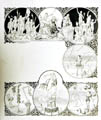|
Thrills and chills have been a part of the American circus since its beginning in 1793. Many people think that all acts in the circus give them the thrills and chills; however there are thrill acts that are performed by daredevils that put them in a category above other circus acts. The daredevil that performs these thrill acts are sometimes referred to as bold and reckless. While the circus daredevil is bold, he is not reckless. If the performer were reckless these acts would result in many fatalities. Circus performers go to new heights to stretch the limits of bravery to develop new “death-defying acts” to amaze and heighten the thrills and chills factor.
There are many circus acts that fit into the thrill act category: human projectiles, bicycles on inclined ramps, slide for life, loop-the-loop auto acts, arm flanges, triple somersault on the trapeze, wire walkers, the seven person pyramid, and some even have cannon balls fired at them.
The human projectiles or human cannonballs have intrigued circus audiences for decades. There have been a number of types of devices that propel the “human bullet” different distances and heights. And Englishman, George A Farini appears to be the first person to use such a device. The date that he first used the “projector” [his name] is unknown; however, he applied for a U.S. patent on June 13, 1871. The firing mechanism for the “projector” was heavy springs made from Indian rubber. Farini’s device did not look like a cannon or a barrel; it was a platform with the rubber springs under it. When released, the platform propelled the person forward.
The first appearance of this device in America was at Niblo’s Garden, New York City, in 1873. It was performed by Lulu, a young man that had a feminine face and body and dressed like a girl. Lulu stood on a platform about one foot square that was flush with the stage floor. When the latch holding the spring was released, Lulu flew upwards of thrity feet and grasped the rope or bars of a trapeze. In 1875 Lulu was performing with the Howes and Cushing Circus and was billed as the “Queen of Trapezists.”
In 1875 Yankee Robinson Circus had a cannon act that was advertised as a “bewildering Howitzer Feat and was shaped like a cannon.” [site] George Loyal, the “Human Projectile,” was shot out of the cannon and caught by Ella Zuilda hanging upside down from a trapeze.
The popularity of these acts continued to spread through the shows through the 1800s; however, by the late 1890s the cannon act had run its course and was replaced with other mechanize acts that reflected the times with a growing interest in the bicycle and the automobile.
In 1904 Barnum & Bailey introduced a daredevil coalled Volo the Volitant (C.B. Clarke), whose specialty was “Cycling the Aerial Arc.” Volo rode a bicycle down a forty-five degree incline that was eighty feet long and forty feet high. Then he flew through the air on his bicycle fifty-six feet, landed on a seven-foot-high platform, and rode to the ground on another ramp.
With the great interest in the automobile in America in the twentieth century, it was inevitable that the next loop-to-loop act would be that of an auto first leaping a gap and then a car looping-the-loop. The structure that the car would travel on was divided into two sections. The first sections, about thirty feet tall, had a small platform where the driver would start his decent. The second section was the landing area for the car and it was located about twenty feet from the first sections.
The auto thrill acts had a great impact on the American circus. According to Fred D. Pfening, Jr. in his article in Bandwagon, May/June 1969, the “golden age of loop-the-loop and leap-the-gap acts with autos and bicycles was from 1900 to about 1912 (20). In 1904 John Robinson’s Ten Enormous Shows Combined introduced the loop-to-loop auto to the American circus audiences. The gentleman doing this loop-to-loop was billed as the Great Mephisto (Horace Mohn). Circuses found that the loop-to-loop acts pleased the crowd. It was a matter of time that the acts became more daring and thrilling. In 1906 Barnum & Bailey in addition to the “dip of death” added a second car to the act with a lady passenger and billed it as “THE LIMIT.” In 1907, Forepaugh-Sells was presenting mid-air somersaulting autos.
In the 1908 season, Barnum & Bailey presented a thrill act, “Sister La Rague” using two cars and a ninety foot runway. “Billed as an aerial auto race, one car painted red dashed down the runway striking an obstruction that tossed it into space for a mid-air somersault, while the other car painted blue followed closely, passing smoothly over the dropped obstructions and jumpting under the red car, in a somersaulting position, to a landing ramp, just ahead of the red car that had left the top of the ramp first.” (Pfenning, Bandwagon p. 23 May/June 1969).
A Barnum & Bailey press release described: “As the car descends the incline it gathers velocity. You are dimly conscious that its speed is so terrific as to be beyond comparison with anything you have ever seen. An express train is seemingly slow beside it. You think of a pistol shot; a speeding arrow; a meteor. It is all three in one. Before you can realize it, the car has descended the incline, turned upside down and still inverted, has shot into space. Twenty feet away, across a veritable chasm of death, is a moon-shaped incline. You breath comes fast. You gasp. Your heart seem to stop pulsating. Will the auto strike the incline? Will it be upright?”
| 



